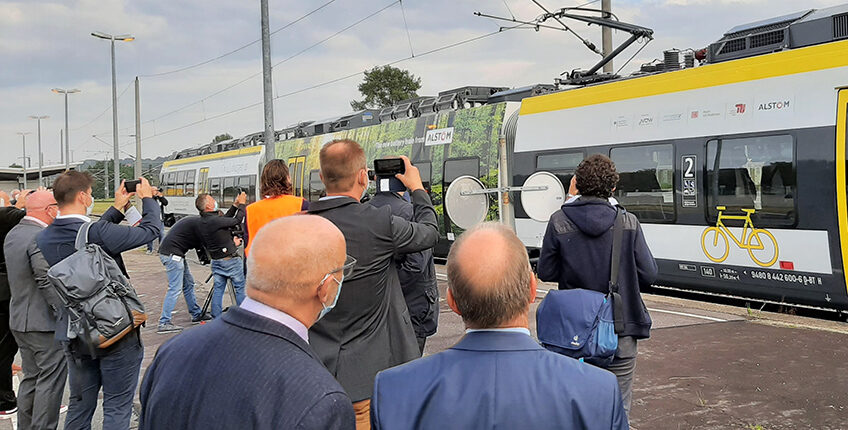Together with TU Berlin, Alstom is laying the groundwork for alternative drives for rail transport. From December, the battery train will begin passenger service in Baden-Württemberg and Bavaria –the first train of its kind approved for regular passenger service in Germany since the 60s.
Alstom’s battery train began its maiden journey in Chemnitz. Developed and manufactured as a prototype in Hennigsdorf, the train travelled through Flöha and Zschopau and then back to Chemnitz. Over the course of the journey it changed its propulsion mode from overhead line to battery-electric operation.
With this train, Alstom is underscoring its technological leadership in alternative rail drive systems. The project originates from research cooperation with TU Berlin which began at the end of 2016. It covers development, approval and the use of battery trains in passenger service, proof of the overall economic viability of battery operation in standard gauge railways and the preparation of recommendations for action for politics, operators and commissioning bodies for using battery trains on non- or partially electrified routes. The core of this technology flagship is the drive system with traction battery, developed and tested in Mannheim. Alstom operates a specialized battery and high-voltage laboratory there.
“Alstom has the clear objective to lead on the international stage in alternative rail technologies. Along with our hydrogen train, this state-of-the-art drive concept with batteries represents another milestone for the market introduction of emission-free regional trains in Germany and worldwide”, says Müslüm Yakisan, President of Alstom in Germany, Austria and Switzerland.
The battery train was developed in cooperation with various project partners. These include DB Regio, Nahverkehrsgesellschaft Baden-Württemberg (Baden-Württemberg local transport company), the National Organisation Hydrogen and Fuel Cell Technology (NOW GmbH) and TU Berlin. The Federal Ministry of Transport and Digital Infrastructure (BMVI) is funding the project with around four million euros.
Since the beginning of the project, the Department of railway operations and infrastructure and the Department of methods of production development and mechatronics have had responsibility for the accompanying scientific research in TU Berlin. The investigations revealed for example, that the large majority of lines currently travelled with diesel trains have non-electrified sections of well under 100 kilometres. Using existing catenary wires enables the deployment of battery-electric vehicles on these lines without any major infrastructural upgrades. Extensive drive dynamics and energy simulations were carried out in the project. Prof. Dr.-Ing. Birgit Milius, Head of the Department of methods of production development and mechatronics, explains: “The evaluations have clearly shown that for local rail transport, battery-electric vehicles have the potential to successfully replace diesel trains. We have always focused on the entire system as a whole. Vehicle, operational and infrastructural aspects were analyzed while taking into account the various operating conditions, in order to obtain reliable results.”
Dr. Harald Neuhaus, Managing Director of Verkehrsverbund Mittelsachsen GmbH emphasizes: “Already in the second half of 2019, through the association meeting of Verkehrsverbund Mittelsachsen (ZVMS), Verkehrsverbund Mittelsachsen GmbH was commissioned with implementing a vehicle concept for the RE6 train on the Chemnitz-Leipzig route. We already had positive experience with Alstom from the procurement of 29 electric multiple units (Coradia Continental) for the Central Saxony electrical network. Successful delivery and maintenance have meant that at the beginning of 2020, vehicles with the latest battery-electric drive concepts could also be added through an addendum to the existing supply contract. It will become a reality starting in 2023. Our passengers will be transported comfortably and with zero emissions on a previously non-electrified route until electrification is completed. We are proud, together with all our partners, to be able to make a contribution to the implementation of innovative drive concepts in Saxony.”
Picture: Flöha train station: The train alternates its propulsion method from overhead line operation to battery-electric. On sections without electricity supply, the drive draws energy from the batteries – that can in turn, be recharged on sections with overhead lines.


